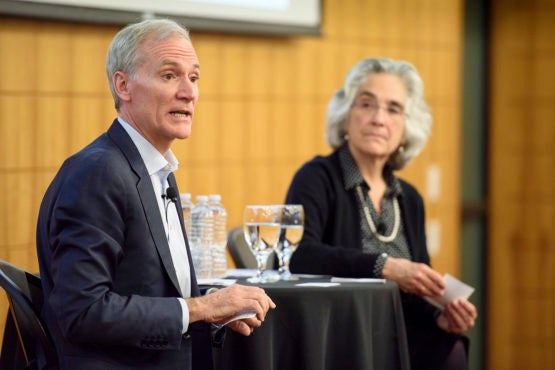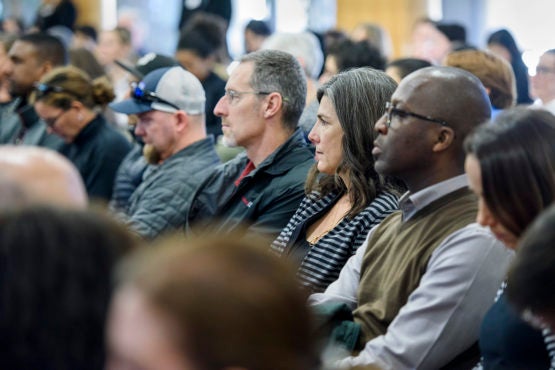Stanford president, provost answer questions during meeting with university community
President Marc Tessier-Lavigne and Provost Persis Drell answered a range of questions on issues from long-range planning to housing availability during a campus community meeting Tuesday.
President Marc Tessier-Lavigne and Provost Persis Drell updated the Stanford community on the long-range planning process and addressed a variety of university issues, from affordability and the Redwood City campus to assistance for undocumented students, during a community meeting Tuesday morning.
Approximately 175 staff, faculty and students attended the hour-long meeting in the Koret-Taube Conference Center in the Gunn-SIEPR Building. It was the second in a series of conversations that Tessier-Lavigne and Drell are hosting during the 2017-18 academic year with the goal of encouraging open communication between university leaders and the campus community.

President Marc Tessier-Lavigne and Provost Persis Drell meet with the campus community on Tuesday. (Image credit: L.A. Cicero)
At the start of the meeting Tessier-Lavigne gave an update on long-range planning, affirming the goals and reviewing the planning process to date.
“The aim is to look out 10 to 15 years and beyond to think about where Stanford can and should go – the opportunities that are available to us, the challenges we should be tackling both in terms of new directions and new ideas, as well as strengthening our community,” Tessier-Lavigne said.
After reviewing and organizing 2,808 individual ideas and proposals, the four area steering groups – organized around the areas of Education, Research, Our Community and Engagement Beyond Our University – produced 37 white papers, which were made available to the campus community last month.
The Executive Cabinet has been reviewing the white papers and the original source materials, as well as listening to feedback from the community, to develop organizational themes that will help shape a vision for the university’s future, said Tessier-Lavigne.
He gave some examples of the themes that have emerged, primarily around two areas: research and education and strengthening the university’s foundation.
Research and education:
- The human experience
- Learning: access, curricular innovation and residential education
- Society and public policy
- Life and health
- Sustainability
- The physical world
- Technology, including artificial intelligence and data science
Strengthening the university’s foundation:
- Diversity and inclusion
- Affordability
- Service and local community engagement
- Health and wellness of our community
- Sustainability on campus
- Infrastructure support
Provost Drell outlined the next steps in the process, including two community meetings this week, school-based meetings and other outreach to solicit feedback from staff, faculty and students. Both Tessier-Lavigne and Drell emphasized the importance of hearing diverse perspectives and having broad participation in the process.
Drell said that a vision will be presented to the Board of Trustees in April and shared with the greater community later in the spring. Planning will begin this summer and the implementation phase will commence in the fall, although she noted that work has begun already on some near-term issues.
In the planning and implementation phases, working groups of campus community members will be involved in recommending operational goals and mapping implementation.
In addressing the development of the vision, Drell said the key issue is, “What is the Stanford we want to be in the decades to come? Once we know that we can start taking the steps to get there.”
In her remarks Drell also focused on housing and affordability more broadly, which she said are critical issues for many people across the Stanford community.
“This isn’t just a Stanford issue; it’s a regional issue,” Drell said. “We have a tremendous amount of input on this topic with many suggestions. What became clear in reading the white papers is that this affects every segment of our population.”
Drell stressed that “there is no one-size-fits-all solution” to housing and affordability and said there is active discussion on how to make sustained, lasting progress.

About 175 members of the Stanford community attended the conversation with President Tessier-Lavigne and Provost Drell at SIEPR. (Image credit: L.A. Cicero)
Flexible work is one way to address affordability and transportation issues, said Drell. She cited the pilot “WeWork” workspace in San Jose. Two pilot sessions involving 200 Stanford employees have completed and a third session will soon be under way. While the evaluation of this program is still in progress, preliminary feedback on the program has been positive from both staff and their managers, she said.
“Flexible work options for staff are something we have to be looking at, given the realities of living and commuting in the Bay Area,” Drell said.
She then turned her attention to the Redwood City campus, which will open in 2019. She emphasized that opening this new campus involves change not just for those staff who will be moving to the new campus, but for everyone at Stanford. Using technology effectively and rethinking working schedules and meeting routines are just a few of the issues the university will need to address broadly as the opening of the campus approaches, she said.
“Change is really hard, but [the Redwood City campus] is terribly important to the university as a whole as it allows us to make thoughtful and strategic use of our space, and to maximize our space for the academic mission,” said Drell. “We want the Redwood City campus to be a great workplace for staff and a lot of effort is going into this.”
Following their opening remarks, Drell and Tessier-Lavigne took turns answering questions submitted by the audience.
In an answer to a question about Stanford’s efforts for undocumented students covered under the Deferred Action for Childhood Arrivals (DACA) program, Drell said the university continues to offer free legal resources, counseling and career resources to students seeking help. She referred the audience to a recent blog post she wrote on the topic, noting additional ways the university can help with covering DACA renewal fees and other assistance students may need.
Tessier-Lavigne answered a question about what advice he would give to seniors graduating in June. He encouraged them to take advantage of the “incredible richness of the Stanford community” and explore courses outside their major, which can have a transformative and enriching effect. As for after graduation, he advised them to keep an open mind because there will be many opportunities to change in the course of a 50-year career.
Student health and well-being was a focus of several audience questions. In response to a question about how the university is handling the issue of sexual misconduct and sexual violence, Drell affirmed the university’s commitment to improving its resources and strengthening its policies. She noted the recent release of the first Annual Title IX/Sexual Harassment Report, which gives the campus community information about the cases of prohibited sexual conduct that have been brought to the university over the previous academic year and the outcomes of cases during that period.
Regarding student mental health, she said, “We are seeing levels of stress that are exceeding what we have ever seen before.” She said the issue is a priority for the university and its Student Affairs leadership, not only in terms of providing clinical services but in terms of promoting wellness within the campus community.
Other topics the president and the provost discussed during the question-and-answer session included resources for fundamental and applied research, the new federal tax on endowment income and the university’s application for an updated land-use permit from Santa Clara County.
